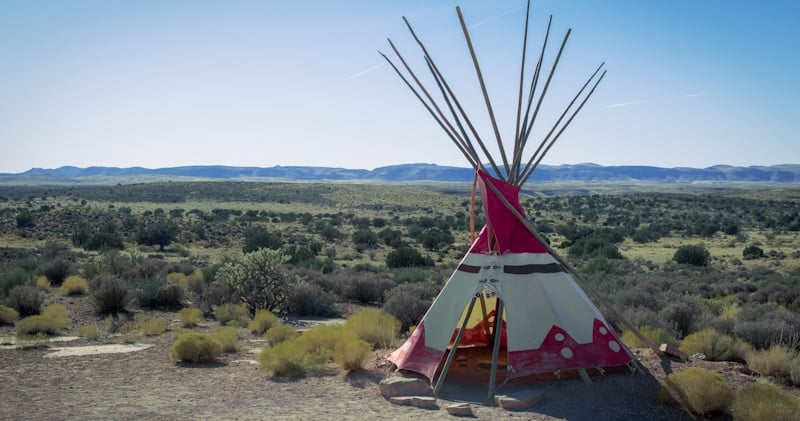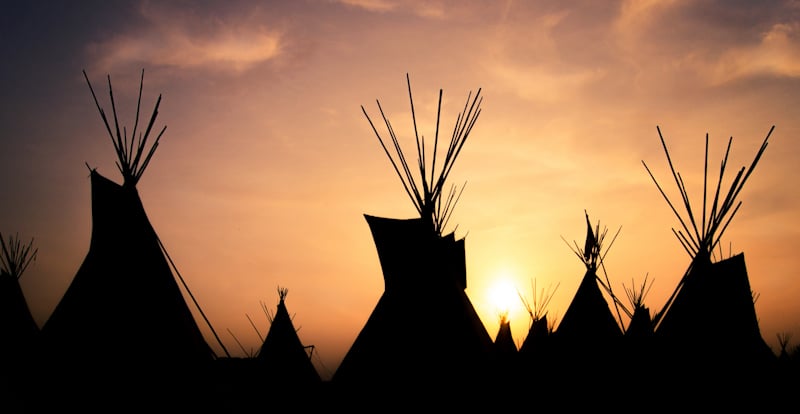Maybe you’ve found the word “tipi” written in various forms across the internet and wonder which is the correct way to spell it? Is it Tipi or Teepee?. This article will cover everything from definitions, history, and etymology, to interesting facts about this historical and cultural shelter for many Native Americans, especially with nomadic lifestyle. This is why it is important to understand the term and use it appropriately.
In regards to the question, all variants such as “tipi,” “tepee,” and “teepee” are correct ways to spell this word. The most recently popular spelling of the term is “tipi” since it matches the International Phonetic Alphabet, but other forms are also valid.
Definition
Tipi/Teepee/Tepee, in simpler words, is a dwelling in which Indians lived. It is characterized by its conical tent and smoke flaps at the top, often used or related to Nomadic Native Americans, specifically the North American Plains Indians and Great Lakes Regions. This is because tepees are great for moving since they are portable and adjust to different temperatures. For example, in the summer, the tepees tent is cooler, and in the winter, the tent tends to be on the warmer side. They are also made of buffalo hides or animal skin, canvas, or cloth and use long wooden poles used to shape it like a cone.
Usage
Many people use this word to describe the shelter or home in which various Native American tribes lived. It holds great historical and cultural significance because this represents an important symbol for tribal identity. It expresses the permanency of traditions and the rich heritage of the Plains Indians. Because most Nomadic Indian tribe’s lifestyles required them to move around constantly, this was a great way to travel from place to place easily while still having a home. Today, it is still present in many Native American communities and is usually constructed for special functions such as ceremonies.
Examples with Sentences
Sentence examples with the spelling “Tepee.”
- The tribe packed all of the food, equipment, and tepees for the next trip.
- Tepee became a famous symbol of tribal identity for many Native Americans. Still, other forms such as igloo, wigwam, and hogan are just as important.
- Tepee’s design is a conical shape.
- Native American men usually painted pictures outside of the Tepee.
- For art class, the kids recreated tepees with some art materials.
- The Sioux Tribe occupied those tepees.
- Tepees would adjust to temperatures easily.
- Modern tepees use canvas.
- A tepee would typically handle twelve to twenty individuals.
- The campfire lit the surrounding of the Tepee.
Sentence examples with the spelling “Teepee.”
- Indian teepees are being preserved.
- They visited some teepees’ reservations on their trip.
- It might require some skills to build teepees with your own hands.
- You can buy teepees on the internet.
- There’s many teepees’ builder that sell them online.
- Native American Plains used teepees.
- Teepees’ paintings hold a symbolic meaning.
- In that valley, there are many teepees close to each other.
- A lot of Native Americans would design their teepees’ village.
- They built a teepee near my hometown.
Sentence examples with the spelling “Tipi.”
- Tipis are made with twelve wood pals and bison skins around the 18th century.
- We set up around ten tipis near the valley.
- The tipis were comfortable shelters to live in and stay the night.
- Children gathered around the tipi.
- Animal skin was used to make the tipis.
- The tipi’s flaps helped to let all the smoke out.
- Chief’s tipi was bigger and is where the majority of meetings took place.
- Usually, tipis would need around fifteen coats to cover the structure.
- Inside the tipis, they were beds made of bison hides.
- Tipis are often called “lodges” in ancient English writings.
Tipi’s design and structure
Tipi’s, as mentioned earlier, is built with big canvas made of buffalo hide and are around 12 feet high and five feet long wooden poles which creates the famous conic shape for which is well known. These poles help the teepee to stand upright by supporting it and make it easier to pack away. Most of the tipis usually held around 4-5 people compared to the chief’s tipi, which was bigger and often used for meetings with larger audiences.
In terms of design, tipi’s would have decorative paintings usually made by men. These paintings would narrate personal experiences which hold significant value. Most Dakota Indians view this as something important, using common symbols like the moon, the sun, circles, diamonds, and a solid background. For example, symbols like a “row of triangles” represented the mountains. The “maltese cross” standing for the morning star expresses powerful dreams, and so many more exciting symbolic meanings that share the culture and history of Native Americans.
Symbolism and spirituality
As stated before, many Native American Plains developed a relationship with symbols creating a connection with the tipi and the spiritual realm. Based on extensive research, the tipi floor symbolizes the mother and the earth. At the same time, the lid represents the father and heaven. Some tipis decorated with paintings were turned into sacred dwellings used for specific rituals. These images showed the contrast of both this world and the spiritual world but also illustrated contacts with supernatural creatures who sent their powers to the visionary.
Etymology
According to Dakota language teachings, the word “thípi” refers to “dwelling or house” and comes from the verb “thí,” which means “to dwell.” Traces of this word has been found in the Sioux tribe, which defines “ti” as “to live” and “pi” as “used for.” In other words, it comes to show the importance of this place to live for many Plains Indians.
Conclusion
Now that we understand the term entirely, we can conclude all variants in spelling of the word “Tipi,” “Teepee,” and “Tepee” are correct. The most common spelling would be “Tipi,” so in that case, due to its popularity, it’s the safest spelling to choose. It’s essential to not only know this information but also learn about the history behind it. As said in the article, it is evident how vital tipis are for Native Americans. It holds both cultural and spiritual significance since it has symbolism and meanings behind them.h Also, this was considered the home for many American Indians and a sacred place to unite. Due to their nomadic nature, tipis were perfect for traveling often, hunting, uniting with the communities, and finding shelter for winter. It’s also important to remember that tipis are not all the same for all Native American tribes. They come from Great Plains, Sioux, Cheyenne, to name a few. But depending on the tribe, the dwellings could be different.
Something impressive about tipis is how durable and adaptable they are. Tipis provided warmth and a lot of comfort in winter’s times, was cooler in the summer, and dry during heavy rains. In general, it was perfect for any weather and easy to disassemble so they could carry it. These dwellings’ portability was an essential thing for Native Americans who had a nomadic lifestyle. The impact of Native American’ culture has been prevalent in history and that’s why there’s many attempts to protect it. Modern tipis for example, utilize canvas nowadays and there’s various business owners that dedicate their time to selling tipis. Also there’s the rise of historical reenactors and their valuable actions to preserve the heritage of tribal identity, as well as their traditions and beliefs.
Shawn Manaher is the founder and CEO of The Content Authority. He’s one part content manager, one part writing ninja organizer, and two parts leader of top content creators. You don’t even want to know what he calls pancakes.



